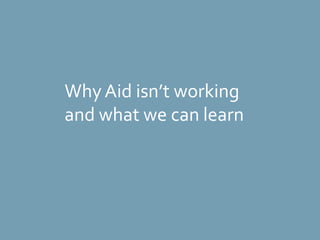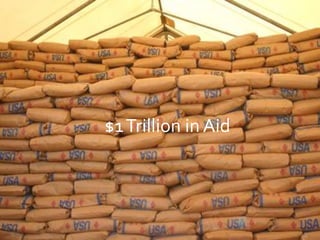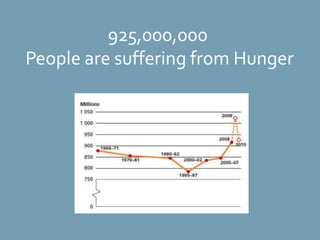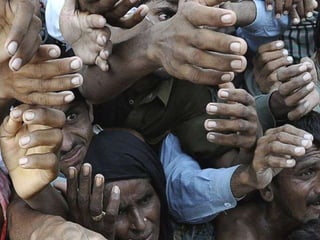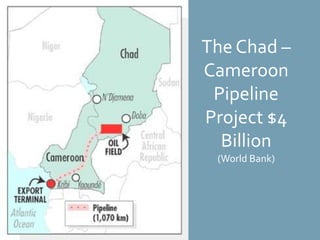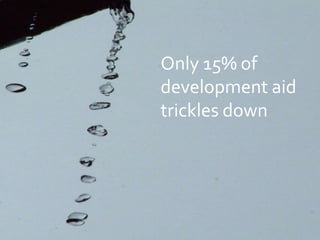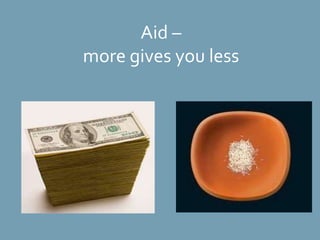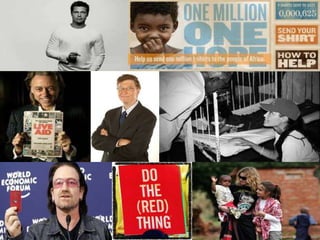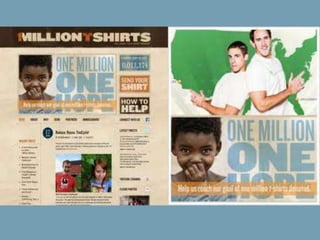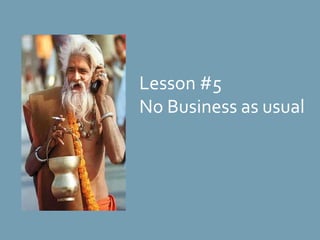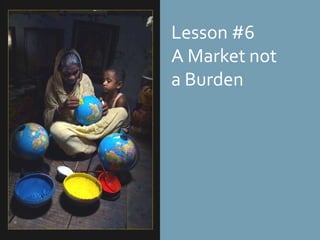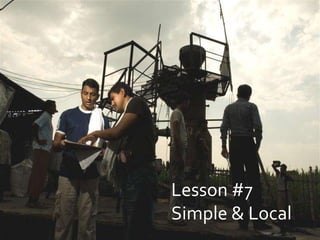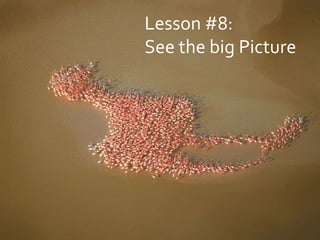Why Development Aid is not working
- 1. Why Aid isn’t working and what we can learn
- 3. $1 Trillion in Aid$ 1 Trillion in Aid
- 5. 925,000,000 People are suffering from Hunger
- 7. The Chad – Cameroon Pipeline Project $4 Billion(World Bank)
- 8. Only 15% of development aid trickles down
- 9. Aid – more gives you less
- 13. Lesson #1 Listen
- 17. Lesson #5No Business as usual
- 18. Lesson #6A Market not a Burden
- 19. Lesson #7Simple & Local
- 20. Lesson #8: See the big Picture
Editor's Notes
- #2: Good Morning!I will show today why development aid paid by governments and large international institutions is not working. I will present 8 lessons that we can be learned from this failed approach and help us to do better social marketing
- #3: The idea of aid and charity is as old as mankind and different cultures found different answers to it. But alms were always combined with something in return: a spiritual advantage, good karma, or forgiveness of sins
- #4: Developmentaid is a story of inefficiencies, corruption and greed. Over the last 60 years $ 1 Trillion has been spent on aid-related projects. And although we spent enormous amounts of money we were not able find lasting solutions to end poverty. $1 Trillion see DambisaMoyo and her book “Dead Aid”.
- #5: For many poor people living conditions are worse than everPoverty is the principal cause of hunger and today about 925 million people (13.6% of the world population) are suffering from hunger.
- #6: The Millennium Development Goals of the United Nations aim to cut the number of hungry people in half. The base year was 1996 and as you can see from the table has not been successful.Picture: Food and Agriculture Organization
- #7: Instead of reducing the number, today even more people are suffering from hunger than in the base year. We produce enough food to feed everyone. But food or land to grow is not equally distributed and aid didn’t change thatThe history of development aid is full of well-intended development projects:
- #8: For example the $4 Billion Chad Cameroon Pipeline project. Instead of spending the oil- money for education or infrastructure, the president of Chad decided to invest in his military to secure the survival of his regime.
- #9: Only asmall portion of aid money trickles down to poor people. Aid is not only inefficient it is often counterproductive and creates more dependency, supports corruption and violence, and destroys local markets and economies
- #10: Aidseems to be a case of more money gives you less. Instead of solving the problems, aid money comes often with strings attached: for example with trade policy restrictions that prevent developing countries from economic growth
- #11: Celebrities pursue a similar money-based approach with questionable results: The RED campaign, for example, spent $50 million on marketing and raised about $25 million for the poor.
- #12: 1 Million T-shirts is an example of a failed campaign. The initiators asked people to send old, used T-Shirt's and planned to then send those 1 Million shirts to Africa. After a huge negative buzz on Twitter and fb and calling the campaign “the dumbest idea” of the year they stopped.So what is then the answer to poverty?
- #13: There is not one answer – there is no silver bullet to solve poverty. But we can learn important lessons from the mistakes like the pipeline project or the t-shirt campaign. We have to give up old thinking and behavior patterns so that social marketing can do better than the 1 Million Shirt campaign
- #14: Lesson 1: We have to stop planning campaigns or projects and begin listening to the poor – they know what is best. And oftentimes it’s not about large sums of money: it is about equal opportunities, respect and empowerment
- #15: Lesson 2: Poorpeople work very hard to secure their survival – they have to be incredible smart, entrepreneurial, and financially savvy to juggle unreliable sources of income and costs of living – we need to recognize these skills and better use them.
- #16: Third: Insteadof thinking what do poor people need or what can we give them from our abundance, we should recognize their assets such as local skills, natural resources and infrastructure and make those assets work
- #17: Lesson 4: We have to create equal opportunities - for example as business partners: the Worldbank sees many African countries as a better business partner than countries such as Spain or China. Africa’s economic growth makes it the world’s 3rd fastest growing region
- #18: Lesson 5: We have to recognize that there is more than one way to achieve a goal. It might not be the way in which we in the western world would do it, but it might be more efficient.
- #19: Lesson 6: It is estimated that the buying power of poor people is $8 billion per day. Why are we donating so much stuff, why don’t we sell it and help them to jumpstart market-based solutions? Instead of sending them our used T-shirts we should support local manufacturers.
- #20: Seven:Solutionsshould be as simple, local and sustainable as possible. This is a picture of the Husk Power System. The company provides electricity from rice husks to 100,000 people in rural IndiaWhy is it important that we change our thinking?
- #21: I cannot tell you if we will get good karma, but I know that we will be benefit greatly from helping the poor. If in our connected world we help to lift the poor out of poverty we help ourselves and create a sustainable, just world.Thank you!

